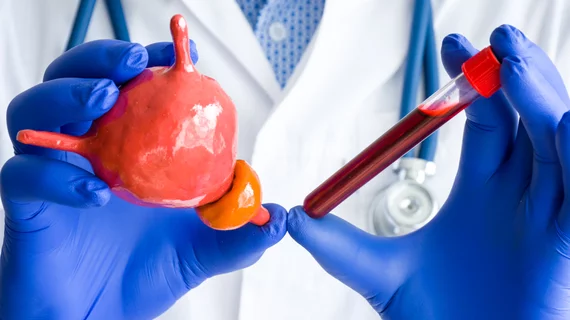Combination therapy that includes new radionuclide proves effective for metastatic prostate cancer
Results from a new study highlight the effectiveness of a new nuclear medicine combination therapy for treating metastatic, castration-resistant prostate cancer (mCRPC).
The Journal of Nuclear Medicine reports that a therapeutic combination of 177Lu-PSMA-617 (recently FDA approved) with idronoxil (NOX66) reduced prostate specific antigen (PSA) levels in 48 out of 56 study participants, 61% of whom experienced a reduction of at least 50%. Experts reported that this combination therapy could help decrease the high mortality rate of mCRPC, for which the five-year survival rate is currently just 30%.
“177Lu-PSMA-617 has shown promising results in prospective single-center studies, the phase 2 TheraP trial, and the phase 3 VISION trial. However, secondary treatment resistance hinders longer-term outcomes for many men,” Louise Emmett, MD, from the Department of Theranostics and Nuclear Medicine at St. Vincent’s Hospital in Sydney, Australia, and co-authors explained. “Combination therapies may overcome resistance mechanisms and improve clinical outcomes.”
The study included 56 men with progressive MCRPC who had been previously treated with taxane chemotherapy and novel androgen signaling inhibitor (ASI). Participants received up to 6 doses of 177Lu-PSMA-617 on day 1 in combination with a NOX66 suppository on days 1–10 of each 6-week cycle. The patients were divided into three groups: cohort 1 received 400 mg of NOX66, cohort 2 received 800 mg and cohort 3 received 1,200 mg. Clinical, blood-based and imaging biomarkers were measured via PET scan and blood work prior to treatment and upon follow-up (average of 21.8 months later).
Out of all participants, 96% received at least two doses of the combination therapy and 46% completed six cycles. PSA levels decreased in 86% of patients, and 61% of participants’ levels decreased by 50% or more at follow-up. Median PSA progression-free survival was 7.5 months, and median overall survival increased to 19.7 months. The authors noted that men with higher tumor volumes did not respond as well to treatment, and that those treated with ASI for more than 12 months had better overall survival
Though effective, the therapy did not come without its side effects. Commonly experienced adverse events were anemia, fatigue and xerostomia, and 38% reported anal irritation after treatment.
“This finding agrees with retrospective analyses of men undergoing 177Lu-PSMA-617 therapy and raises questions about the timing of PSMA-targeted therapy in men with mCRPC, suggesting that earlier referral for treatment after prior treatment failure may both improve treatment responses and prolong survival, the authors concluded.
Related prostate cancer content:
New MRI technique 'lights up' prostate cancer
FDA approves new radioligand therapy for PSMA positive metastatic prostate cancer
New radiotracer that detects prostate cancer recurrence produces 'stunning' results
Men treated for prostate cancer have increased fracture risk, yet few complete DXA screening
MRI-guided radiotherapy for prostate cancer cuts treatment side effects in half

